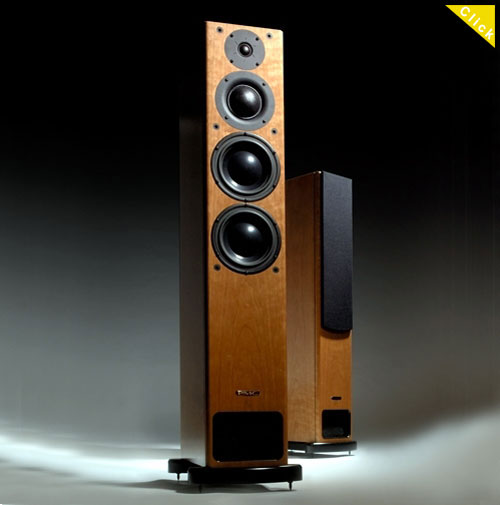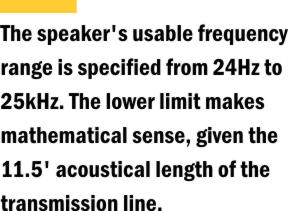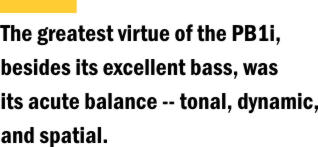PMC • PB1i Loudspeakers
s I begin typing this paragraph, I feel pangs of nostalgia. In the 1970s, I bought my first high-end audio product, the IMF Studio Mk 2, a British transmission-line speaker, and wrote my first review on the Bowers & Wilkins DM6, another medium-sized British floorstander, for Stereophile, the mother of the truly critical audio-review periodicals (or make that "sporadicals," for its very irregular publishing schedule at the time; RIP JGH).
It's cool, therefore, that my first assignment for The Audio Beat is to review a loudspeaker, a keen interest from my very earliest days as part of the audio press. A loudspeaker has always seemed to me to be like the proverbial bee: it shouldn't fly, but it does. What could be more alluring? Dynamic speakers are the most fascinating to me. They remind me of the piston engine (I loved cars even before high-end audio), with all those parts moving up and down and finally producing useful rotary motion. How could this be? All those crossovers and cones and domes in boxes, the signal divided into separate parts, and still a speaker produces a good facsimile (at least sometimes) of live music. Amazing. For those of you unfamiliar with PMC, it's a British company with quite an extensive line of speakers, ranging in size from two-way minimonitors to humongous three-way floorstanders, all of which employ transmission-line bass loading, something that is not uncommon but is unique in an entire product line. The PMC line started with the company's largest speaker, the BB5 ("BB" stands for "Big Box"), which used a 15" woofer. It was designed in the early '90s as a powered three-way monitor for use by the BBC. Thus, PMC began as a producer of professional monitors and the company is still one of the larger suppliers worldwide. A transmission line is theoretically an infinitely long tube that provides a path for the backwave of a driver, almost always a woofer, to escape with minimal reflection back to the driver. The tube is filled with damping material that slowly absorbs the backwave, which is what makes a transmission line different from the older labyrinth enclosure. The damping slows up the backwave and increases the acoustical length of the transmission line relative to its physical length. Balancing bass control and bass quantity is where the designer of a transmission-line speaker really shows his stuff. The PMC PB1i costs $13,499 a pair, which is sort of Buick-level pricing these days, although still a lot of money. Visually it is a simple box, but as the architect Mies van de Rohe once wrote, "God is in the details." In this case, that applies both visually and acoustically. By having two small woofers and a narrow, deep cabinet, the PB1i becomes elegant and unobtrusive. Its carefully book-matched veneers, rounded front corners (which also reduce edge diffraction) and elegant, curved, contrasting black bases add to the looks. The narrow front combined with natural reinforcement of the internal transmission line help to create a more rigid enclosure than is normally expected from its conventional, double-veneered, 3/4"-MDF construction. The largest acoustically critical surface span is about 6 1/2", which beneficially raises the first resonance point of the enclosure, making it less noisy, an effect I confirmed with the very unscientific "knuckle rap on the box" test during loud passages. Vibration was there but noticeably less than I normally feel for speakers with less-than-heroic construction. The driver lineup consists of two 6 1/2" woofers, custom made for PMC for this application, a 3" Scan-Speak dome midrange loaded by a short damped tube (almost a short transmission line), and a 1" dome tweeter, another special PMC design. The fourth-order Linkwitz/Riley crossover has become popular in the last few years, and I have found it to work extremely well when carefully implemented. The crossover points are 380Hz and 3800Hz.
The PMC transmission line has one unique design feature that I haven't seen until now. The woofers in all other transmission-line designs of which I'm aware are at the very end, but PMC positions the drivers about a third of the way from the beginning. I was curious about this, so I inquired and was told that research showed this reduced harmonic distortion compared to other transmission-line formats. Regarding setup and use, the PB1i is probably best in a medium-sized room and at least a few feet away from any walls. Its deep bass response could make integrating it into a small room or near reflective surfaces hard work, and its small woofers could be a handicap when it comes to filling up extremely large spaces. s this is my first review in eons, making me essentially an unknown, some comments about my views on audio reviewing are in order. Writing a review is a process that requires learning about yourself as a listener as much as it does discovering the capabilities of the equipment you're evaluating; you have to understand what you hear as much as simply recognize what the product accomplishes -- or doesn't. Conversely, reading a review is as much about learning who the reviewer is as it is about the product covered. I expect the best reproduction to sound "alive" -- at least with fine software. That means it exhibits transparency, detail, openness, focus, grip, weight, and other things that appeal to us audiophiles. Far more important to me, however, is a lack of anything between me and the performance. I want to believe I can reach out and touch the musicians, so retrieval of detail must be high, but even more important is dynamic range. This doesn't refer to sheer loudness but rather the ability to reproduce changes in level, both large and small, with minimal compression. Otherwise reproduced sound is like a wide-bandwidth radio, not hi-fi. A lack of tonal coloration is of secondary importance to me, so long as it's not overt. After all, a change of seat in a concert hall changes the tonal balance of the music. Indeed, the reproduction of dynamics still sounds "alive" if you go out of the hall and listen from the lobby, where the octave-to-octave balance is drastically altered. However, I repeat, I'm only speaking about minor coloration. Quickly noticeable skewing of tonality is simply unacceptable. I am also not a freak for soundstaging and imaging. Images do need to be stable and the presentation must display depth, both of which are necessary to the tactile feeling I want to achieve, but reproduction doesn't need to go to extremes. Finally, most of my auditioning of an audio product is straightforward: I just sit down and listen to a great deal of music -- whatever I feel like at the time, but largely classical and folk with a smattering of other types. There are two CDs that I play short portions of to begin my listening. They give me a quick sense of whether the product I'm listening to gives me the elusive sense of "aliveness." One is the Evgeny Kissin recording of the keyboard version of Mussorgsky's Pictures at an Exhibition [RCA 63884-2]. Piano is the most dynamic instrument, and this is one of those rare recordings that proves it. Another is the first Pentangle recording [Castle Music CMRC 131]. When a system is good, the guitars on this recording explode from the speakers and Jacqui McShee's voice is open and clear. The drums are so tight you can hear the skin tone, the decay is not muddled, and the upright bass growls. (By the way, for trivia's sake, this was the first non-classical recording reviewed in Stereophile.) Of course, after extended listening to the product under test, I go back to my reference to ensure that what I think I heard is what I did hear. This is repeated several times. My reference speakers are almost unique, so a few words on them are in order. It is a true speaker system comprising six separate pieces. The treble/midrange module is a Froy III, a kit speaker designed on commission from SEAS by Murray Zeligman. Murray has been a professional in audio for many decades. The Nova speakers from the 1990s were his designs. The Froy III is a D'Appolito, bass-reflex design using two 5" SEAS Excel magnesium-cone drivers and a SEAS Millennium soft-dome tweeter. The bass module for my speaker system is a 5.25-cubic-foot box housing an 18" woofer -- the same driver used for the last Snell Model A. The box is configured for both reflex and infinite-baffle loading. The reflex loading provides minimal time delay and a -3dB point of 23Hz. The infinite-baffle loading is somewhat tighter than maximally flat and provides bass that's -3dB at 33Hz. Murray designed the woofer crossover only to be used in conjunction with the Froy III. The Froy III alone goes down to the mid-40Hz range. Adding the woofer not only extends the bass but adds to the fullness of the imaging. Interestingly, it also improves the definition of the midbass and opens up the sound for a couple of octaves into the lower mids. I prefer very tight bass over bass with bloom, so I stuff the ports of the woofers, giving me tighter, more defined bass -- with the loss of a little weight as a byproduct. With the ports open, the sound is fuller and goes a bit deeper. I suspect this is more accurate and also more "alive," yet many will find the stuffed version to be better damped and more defined, as I do. or the first couple of weeks, I listened to the PMC PB1i's while trying not to be a reviewer -- something not entirely possible, of course. I was attempting to perceive the speaker as a whole without listening for specific details. However, two things stuck out consistently: rich, full, well-defined bass and a touch of treble prominence. I suspect that the treble issue could be the result of flat on-axis response that's similar to that of my reference speakers. The bass gave validity to the transmission-line loading. It appeared to reach at least as low as that of my reference speakers, with their much larger woofers, and presented low frequencies with similar weight as well. The piano on the Kissin Pictures had real heft and scale, which are too often missing in the reproduction of piano, making the instrument appear physically small. The PB1i presented the piano as a large instrument -- just as it should be. And, of course, the bass had a similar effect on large-scale music like symphonic works, giving them a sense of heft and grandeur. The PB1i may not be a large, physically imposing speaker, but its bass reproduction belied its proportions. Soundstaging provided ample space and acute image placement. The classic recording of the Rutter Requiem from Reference Recordings [Reference Recordings RR-57CD] was especially illustrative, conveying a three-dimensional soundscape, especially in terms of depth and height. Besides the normal factors that produce this kind of soundstaging and imaging, a large part of the credit for this three-dimensionality again goes to the full bass, which conveys low-frequency ambience, filling out the stage. This was very impressive from a speaker with as small a footprint as the PB1i. Tonal coloration was low -- something I would expect from a speaker made by a company that manufactures professional monitors. In particular, no tonal aberrations appeared with every piece of software. If I did notice some sort of coloration, it should vary when changing software and be the sort of thing that could be attributed to a change of seat in a concert hall, for instance. And that's what I heard over a couple of months of listening to the PB1i's. There were no consistent tonal issues over long-term listening.
Thus, only a tiny bit of the magic -- something extra from the great (and very costly) speakers I've heard, none of which are perfect either -- was missing, and that's hardly a criticism, given this product's price. Furthermore, the PB1i didn't embody a mix of pluses and minuses that made it sound good with some music and not so good with other. This speaker was a happy combination of positives without the kind of flaws that distract from enjoying your music. verall, I found the PMC PB1i to be a very capable
speaker that did essentially everything well. It was also elegant and non-intrusively
décor friendly. It is a speaker that due to its balance of virtues you can just relax
with, enjoying the entirety of your music collection. Who doesn't want that?
|


 The speaker's usable
frequency range is specified from 24Hz to 25kHz. The lower limit makes mathematical sense,
given the 11.5' acoustical length of the transmission line. Note that if you try to
measure it, the physical length is around 8', but the damping slows down the driver's
backwave so that time-wise the physical length matches the quoted acoustical length.
The speaker's usable
frequency range is specified from 24Hz to 25kHz. The lower limit makes mathematical sense,
given the 11.5' acoustical length of the transmission line. Note that if you try to
measure it, the physical length is around 8', but the damping slows down the driver's
backwave so that time-wise the physical length matches the quoted acoustical length. The greatest virtue of the
PB1i, besides its excellent bass, was its acute balance -- tonal, dynamic, and spatial. It
did darned near everything very well, and what criticisms I had of it were relatively
minor -- and perhaps most meaningful to me. It displayed a tad less impact and slightly
reduced dynamic prowess than I am used to -- the elements of sounding "alive"
were somewhat diminished. The Kissin Pictures was impressive, but it did not quite
reach the transient peaks with ultimate speed and snap. Jacqui McShee's voice on the
Pentangle CD was a little smoother than I've heard, as if the microdynamics, those small
shifts in volume, were smoothed over a bit. Decay was very good but not quite as well
damped -- able to settle into the noise floor --as the best I've experienced. With a drum
solo on the Pentangle CD, I didn't get the same sense of the drumhead returning to neutral
after being struck as I do with my reference speakers, nor could I hear the subtle tonal
changes in the decay of the guitars of Bert Jansch and John Renbourn. But I heard this
very rarely with most speakers, and with the PB1i, the guitar decay was cleaner than from
all but a few of the very best speakers I've experienced.
The greatest virtue of the
PB1i, besides its excellent bass, was its acute balance -- tonal, dynamic, and spatial. It
did darned near everything very well, and what criticisms I had of it were relatively
minor -- and perhaps most meaningful to me. It displayed a tad less impact and slightly
reduced dynamic prowess than I am used to -- the elements of sounding "alive"
were somewhat diminished. The Kissin Pictures was impressive, but it did not quite
reach the transient peaks with ultimate speed and snap. Jacqui McShee's voice on the
Pentangle CD was a little smoother than I've heard, as if the microdynamics, those small
shifts in volume, were smoothed over a bit. Decay was very good but not quite as well
damped -- able to settle into the noise floor --as the best I've experienced. With a drum
solo on the Pentangle CD, I didn't get the same sense of the drumhead returning to neutral
after being struck as I do with my reference speakers, nor could I hear the subtle tonal
changes in the decay of the guitars of Bert Jansch and John Renbourn. But I heard this
very rarely with most speakers, and with the PB1i, the guitar decay was cleaner than from
all but a few of the very best speakers I've experienced.